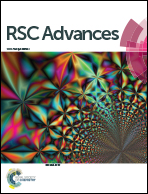Formation of larger-area graphene from small GO sheets in the presence of basic divalent sulfide species and its use in biomass conversion
Abstract
Basic divalent sulfide species exhibit unique chemical activity in that they react with organic matter and function as a redox reagent. Herein, graphene oxide (GO) was modified by basic divalent sulfide species, and the modified materials were characterized by FT-IR spectra, XRD, UV-Vis, SEM, HRTEM, XPS, TG-MS analysis, Raman spectroscopy and electrical conductivity measurements. The results indicated that basic divalent sulfide species removed the abundant oxygen-containing groups from the basal plane of GO, in which the π-conjugated structure was largely restored. The basic divalent sulfide species also react with marginal oxygen-containing groups and were doped into GO to form large-area π-conjugated structures, resulting in the high electrical conductivity of sulfur-modified GO (SGO). TG-MS analysis showed that the basic divalent sulfide in SGO can be removed by heating, which provides a new method for preparing larger-area graphene sheets from GO with a smaller average size. In addition, SGO prepared without annealing displayed better performance in converting fructose, glucose, cellobiose and cellulose to 5-hydroxymethylfurfural (HMF) because it retained some acidic marginal oxygen-containing groups and basic divalent sulfide species.


 Please wait while we load your content...
Please wait while we load your content...